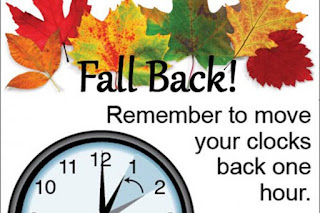Tonight we “fall back” to standard time. While I welcome the change, as I walk at 7:30 in the morning and sunrise has been later and later, not everyone feels that way.
The time change does affect people in different ways. Many report feeling sluggish, tired and even depressed when the clocks falls back. Those who are subject to seasonal affective disorder (SAD), find it more noticeable after the time change. However, the good news is that most people adjust in a day or two.
Below are some tips to help make the adjustment easier.
Set clocks before going to bed. This is a good time to check batteries in smoke and radon detectors as well as any medically related devices that require batteries. Note that devices like smart phones and computers will automatically make that change for you.
Take meds according to the clock. If you take your medications at 8 am and 8 pm, continue to do so. Use your phone alarm to alert you. There are few medications that will be adversely impacted by an hours delay. One exception is pain medications. While easing into the change by waiting 15 minutes, then 30 and so forth until you’ve adjusted to standard time can be helpful, it may not be appropriate for everyone. If you have questions about your meds, talk to your medical provider.
Go to bed later on Saturday with the idea that you’ll wake up closer to your normal time on Sunday morning.
Stick to your schedule: Getting up at the same time and keeping it as normal as possible will help make the shift a bit easier.
Have a nighttime ritual to help ease yourself into sleep.
Avoid long naps as it will disrupt your sleep.
If you are affected by SAD: Living in the north, SAD is more of an issue than for our southern counterparts. Symptoms may include: feeling depressed in a seasonal pattern. Tired or low energy. Loss of interest in activities you normally enjoy. Changes in appetite or weight gain. Sleeping too much.
If you think you may be dealing with SAD, consider the following:
- Talk to your medical provider about how you are feeling
- The Danish practice of “hygge,” (pronounce HOO-ga) is all about creating a warm atmosphere and enjoying life with others or alone. Research shows that it can help reduce the impact of SAD. Check out the following links: Reviving Hyggefor Covid 19 Eight Ways to Find ‘Hygge’ This Pandemic Winter
- Light boxes can be helpful. You’ll typically sit in front of the light box about 20-30 minutes a day. This will result in a chemical change in your brain that boosts your mood and alleviates symptoms of SAD. It’s recommended that the light box is used within the first hour after waking up. Ask your medical provider for tips in selecting a light box.
- Dawn simulators can help some people. Instead of waking up abruptly with beeping or loud music, they produce light that gradually increases in intensity just like the sun. Use full spectrum light simulators as this is the closest to natural sunlight.
- Go outside and enjoy the sunlight: While I walk between 4-5 miles a day, last December I started walking three days a week with a friend. No matter the temps or the weather, we walked. On the coldest of days we had icicles hanging from our hats and masks, and on the hottest buggiest days we used fans to keep the mosquitos at bay. I find I look forward to these walks and it did a lot to get us through a dark Vermont winter. Definitely recommend a walking partner.


This comment has been removed by a blog administrator.
ReplyDelete